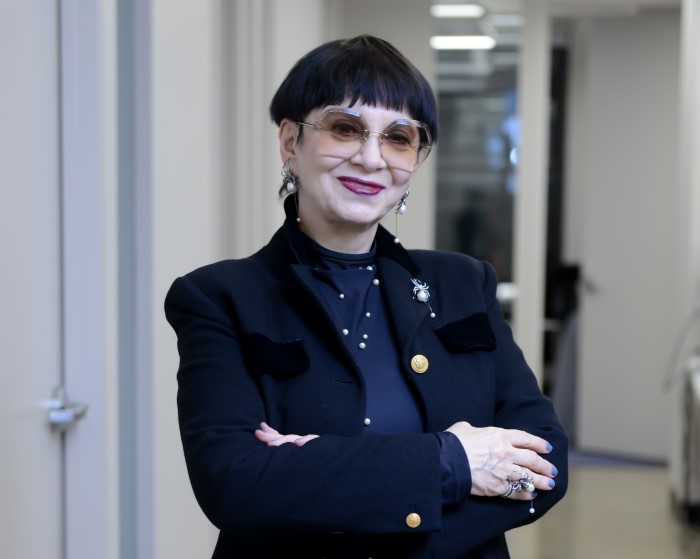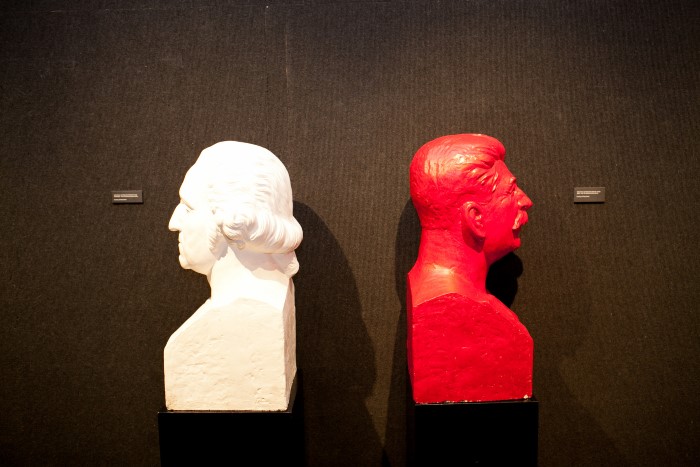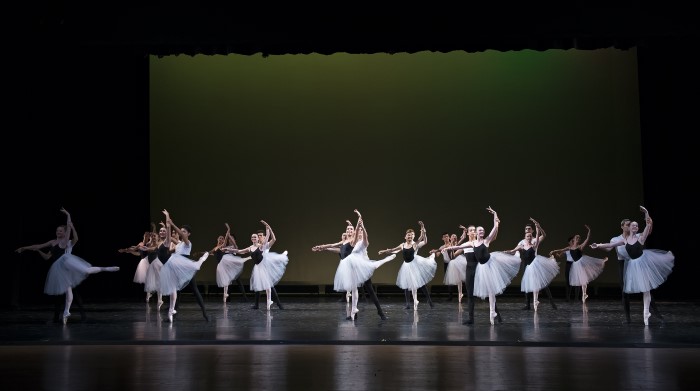
Marina Kovalyov’s “American Dream”
/ Главная / Russkiy Mir Foundation / Publications / Marina Kovalyov’s “American Dream”Marina Kovalyov’s “American Dream”
As a public figure, producer, businesswoman, patron, and participant in a multitude of philanthropic endeavors, Marina Kovalyov is one of the primary “movers” of the American Russian-speaking community. In 1997 she and her daughter found the Russian American Foundation, which promotes interest in Russian language and culture, and she also organizes American-Russian cultural exchange projects.
- Reading through a list of your honorary titles and awards, I came upon a prize you received long ago from TV Channel 13. It’s called “Immigrant Women Achieving the American Dream.” Do you agree with this wording? And what do you understand the “American Dream” to be?
I agree with the way it’s worded. My “American Dream” is starting from zero and soaring to what seems like an unattainable height in a pursuit that matters to you. I’ve had this happen on three occasions.

Marina Kovaleva
The first time was when I started as a totally unknown research at a Russian museum and became the curator of one of the best museums in the U.S., the Brooklyn Museum.
The second time was when—knowing nothing about the U.S. tourist industry—I founded the People Travel Club, a “Russian tourism empire” that eventually became a leading travel agency for Americans.
The third time was when, along with my daughter, I founded the Russian American Foundation, which exposed hundreds of thousands of Americans to Russian art and culture through major undertakings in the U.S. Among these were performances by the Sovremennik theater on Broadway, the yearly Russian Heritage Festival, a master class by the Bolshoi Ballet Academy, and many others….
—Not long after emigrating in 1979 you worked in the renowned Brooklyn Museum, but then you decided to leave your career at the museum and transition to the tourism business. What pushed you to take this step? Why does it happen that people completely change their field of work after moving to a new country?
I think that when we move to another country we all dream of remaining in the same profession. But most often life works out differently.
My association with the Brooklyn Museum lasted for about four years. I expected to work in this quiet and esteemed museum for the rest of my days. But upon arriving at work one day I learned that the new president, Reagan, had announced government cutbacks. And since I was the last to join the museum, I would be the first out—despite the colossal amount of successful work I had done. So there I was on the street. The unions, the museum director, and my colleagues were able to get me reinstated, but that didn’t cheer me up. I began to feel a constant anxiety: what if it happened again? I decided to leave of my own accord and create my own business where the present and the future would depend more on me. And that’s how the People Travel Club got started.
—On account of your active social life you meet lots of very interesting people. Please tell us about the people who mean the most to you in the Russian-American community.
—The people I care about can be divided into two groups: past and present. If we’re talking about the Russian-Americans of my generation, that is, the so-called “third wave” of emigration, absolutely everyone means a lot to me. We all arrived together to “discover” our America…
Last year I arranged a project called “The Third Wave and ‘Novy Amerikanetz’: Russian Culture in New York 1970-1990” to tell the story of these Russian Americans, both those who are still close by and those who are already gone… I want to tell people about the time that gave us our start. Our first offices were the size of a single desk, but they were, of course, on Fifth Avenue.
At the time we were caught up in our daily routines and didn’t sense the significance of that historical moment, when we were led chiefly by Sergei Dovlatov’s talented newspaper, Novyi Amerikanetz….

At the exhibit, “The Third Wave and "Novy Amerikanetz’: Russian Culture in New York 1970-1990"
We can approach this period through the lenses of photographers like Nina Alovert, Marianna Volkova, Nataliya Dyakovskaya, Lana Ford, Leonid Lubianitsky, Lev Poliakov, Mark Serman, Yuri Shalamov, Natalia Sharymova… And through the works of artists like Vagrich Bakhchanyan, Vitaly Dlugy, Ilya Kabakov, Yuri Krasny, Vitaly Komar, Alexander Melamid, Igor Tulipanov, Mikhail Turovsky, Konstantin Khudyakov, Mikhail Shemyakin….
— I’m sure you could also name someone from the younger generation.
—Of course, the present-day Russian-American community is inhabited by a multitude of remarkable, outstanding, surprising people, and one could gush endlessly about them. But for me it starts with Sonya Bekkerman. At the age of 29 Sonia has become the vice president of Sotheby’s, put together hundreds of private collections and museum-quality expositions, and helped build interest in Russian art not only in American, but all over the world. When she had reached the height of her extraordinary career, her technology project TondoArt appeared. This is a platform for helping the layperson understand contemporary art. Sonia is also a very warm, sincere person. She is passionate about history and foreign languages and knows a thing or two about world cuisines.
Another notable figure is Philippe Quint: a violinist and educator… He plays a 1708 “Ruby” violin made by Antonio Stradivari. Philippe opened the famous Hollywood Ball and received several Grammy nominations. He plays all over the world, with some of the best orchestras. He’ll fly in from some country or other and burst into my office overflowing with new ideas, and I’ll be infected with his youth and creativity.
—The Russian-American Foundation (RAF) was started in 1997. One of its current aims is to support activities that further “the preservation of the Russian language and the historical cultural heritage of Russian speakers.” How is this wonderful aim put into practice?
—Twenty years is a long time for a foundation to be around. At the beginning we fought to make a name for ourselves. We chose flashy projects, invested in them both professionally and financially, and kept them going at any cost—all just to ensure that people heard about, and believed in, us.
Now the RAF is a recognizable name, and it’s not uncommon for us to open the doors for new projects that could only be realized with us. We maintain a high professional level in all of our undertakings.
One of our most popular projects is devoted to children’s ballet. Every summer around 600 American children study in our ballet program all over America and the rest of the world. In addition to learning the fundamentals of Russian classical ballet with professors from the Bolshoi Ballet Academy, they also study Russian music, the Russian language, and Russian traditions.

A ballet program arranged by RAF and the Bolshoi Ballet Academy in New York
Yet another program is devoted to education about Russian language and culture. Every year we send a group of American children to Russia for six weeks. The kids study with educators from Monday through Friday, and on the weekends they stay with host families in order to learn about the lives and traditions of Russians, as well as making friends with their Russian peers. We also regularly sponsor literary projects in collaboration with Columbia University, the Kennan Institute, and other organizations.
—Tell us about the Russian Heritage Festival, now going on its 15th year.
– We started holding this festival in conjunction with New York Mayor Michael Bloomberg. He treated the Russian-speaking community very kindly. Every year he would learn some new Russian words and come for the opening ceremony. He would help us give out awards to those who supported Russian-American dialogue.
In the first year, the festival went for a week, and since then it’s always been a whole month. The opening is held in the Metropolitan Museum of Art in the presence of the art community, politicians, and business leaders. They close the Met for us and only our guests can attend the opening in the museum’s main Egyptian hall. The other days of the festival take place in various prestigious places throughout the city. There are exhibitions, concerts, lectures, and film screenings..
We bring in folk music groups from Russia and invite the best Russian and American classical musicians. We involve universities, libraries, and theaters. Since the festival takes place in June, many of the events are held in parks. A sizeable number of events are free-of-charge in order to allow thousands of Americans to come into contact with Russian culture. The festival engages thousands of children from American and Russian families, who learn about the Russian language and musical tradition, as well as dances from the nations of the former USSR.
—What local media outlets support your efforts?
— The New York Post has set aside 16 pages specifically for our events. I don’t think anyone else does that kind of PR for Russia in America! Nonetheless, people don’t really pay much attention to us in Russia yet. But we don’t worry about it and just keep doing our work. Because what we do isn’t a business—it’s a mission!
Anna Genova
New publications

 Mikhail Kalatozov, a director who transformed the world of cinematography in many ways, was born 120 years ago. He was a Soviet film official and a propagandist. Above all, he was capable of producing movies that struck viewers with their power and poetic language.
Mikhail Kalatozov, a director who transformed the world of cinematography in many ways, was born 120 years ago. He was a Soviet film official and a propagandist. Above all, he was capable of producing movies that struck viewers with their power and poetic language.  Ukrainian authorities have launched a persecution campaign against the canonical Ukrainian Orthodox Church (UOC), the biggest one in the country's modern history. Over the past year, state sanctions were imposed on clergy representatives, searches were conducted in churches, clergymen were arrested, criminal cases were initiated, the activity of the UOC was banned in various regions of the country, and monasteries and churches were seized.
Ukrainian authorities have launched a persecution campaign against the canonical Ukrainian Orthodox Church (UOC), the biggest one in the country's modern history. Over the past year, state sanctions were imposed on clergy representatives, searches were conducted in churches, clergymen were arrested, criminal cases were initiated, the activity of the UOC was banned in various regions of the country, and monasteries and churches were seized.  When Nektary Kotlyaroff, a fourth-generation Russian Australian and founder of the Russian Orthodox Choir in Sydney, first visited Russia, the first person he spoke to was a cab driver at the airport. Having heard that Nektariy's ancestors left Russia more than 100 years ago, the driver was astonished, "How come you haven't forgotten the Russian language?" Nektary Kotlyaroff repeated his answer in an interview with the Russkiy Mir. His affinity to the Orthodox Church (many of his ancestors and relatives were priests) and the traditions of a large Russian family brought from Russia helped him to preserve the Russian language.
When Nektary Kotlyaroff, a fourth-generation Russian Australian and founder of the Russian Orthodox Choir in Sydney, first visited Russia, the first person he spoke to was a cab driver at the airport. Having heard that Nektariy's ancestors left Russia more than 100 years ago, the driver was astonished, "How come you haven't forgotten the Russian language?" Nektary Kotlyaroff repeated his answer in an interview with the Russkiy Mir. His affinity to the Orthodox Church (many of his ancestors and relatives were priests) and the traditions of a large Russian family brought from Russia helped him to preserve the Russian language.

 The leaders of the Friends of the Great Russia cultural association (Amici Della Grande Russia) in Italy believe that the Western policy of abolishing Russian culture in Europe has finally failed. Furthermore, it was doomed to failure from the beginning.
The leaders of the Friends of the Great Russia cultural association (Amici Della Grande Russia) in Italy believe that the Western policy of abolishing Russian culture in Europe has finally failed. Furthermore, it was doomed to failure from the beginning.  Name of Vladimir Nemirovich-Danchenko is inscribed in the history of Russian theater along with Konstantin Stanislavski, the other founding father of the Moscow Art Theater. Nevertheless, Mr. Nemirovich-Danchenko was a renowned writer, playwright, and theater teacher even before their famous meeting in the Slavic Bazaar restaurant. Furthermore, it was Mr. Nemirovich-Danchenko who came up with the idea of establishing a new "people's" theater believing that the theater could become a "department of public education."
Name of Vladimir Nemirovich-Danchenko is inscribed in the history of Russian theater along with Konstantin Stanislavski, the other founding father of the Moscow Art Theater. Nevertheless, Mr. Nemirovich-Danchenko was a renowned writer, playwright, and theater teacher even before their famous meeting in the Slavic Bazaar restaurant. Furthermore, it was Mr. Nemirovich-Danchenko who came up with the idea of establishing a new "people's" theater believing that the theater could become a "department of public education."  "Russia is a thing of which the intellect cannot conceive..." by Fyodor Tyutchev are famous among Russians at least. December marks the 220th anniversary of the poet's birth. Yet, he never considered poetry to be his life's mission and was preoccupied with matters of a global scale. Mr.Tyutchev fought his war focusing on relations between Russia and the West, the origins of mutual misunderstanding, and the origins of Russophobia. When you read his works today, it feels as though he saw things coming in a crystal ball...
"Russia is a thing of which the intellect cannot conceive..." by Fyodor Tyutchev are famous among Russians at least. December marks the 220th anniversary of the poet's birth. Yet, he never considered poetry to be his life's mission and was preoccupied with matters of a global scale. Mr.Tyutchev fought his war focusing on relations between Russia and the West, the origins of mutual misunderstanding, and the origins of Russophobia. When you read his works today, it feels as though he saw things coming in a crystal ball...